Poland
1966
"Prehistoric animals"
| Issue Date |
05.03.1966 |
| ID |
Michel: 1655-1663
Scott: .1395-1403
Stanley Gibbons: 1639-1647Yvert: 1506-1514
UPU: N/A
Category: pR |
| Author |
Andrew Heindrich |
| Stamps in set |
9 |
| Value |
20
gr Dinichthys
30 gr Eusthenopteron
40 gr Ichthyostega
50 gr Mastodonsaurus
60 gr Cynognathus
2.50 zl Archaeopteryx
3.40 zl Broutotherium
6.50 zl Machairodus
5.60 zl Mammuthuss |
| Size (width x height) |
39,5 X 51 mm / 51 x 39,5 mm |
| Layout |
|
| Products |
FDC x 4 |
| Paper |
coated paper |
| Perforation |
11x11,5 |
| Print Technique |
Offset |
| Printed by |
|
| Quantity |
20 gr 8 (Milion, 30 gr 6 minim',
40 gr 6.5 million, 50 gr 4.5 million,
60 gr 6 million, zl 2.50 2.5 million,
zl 3.40 2.5 million, zl 6.50 1.4 miniom
zl 7.10 1.4 million. |
| Issuing Authority |
Poczta Polska |
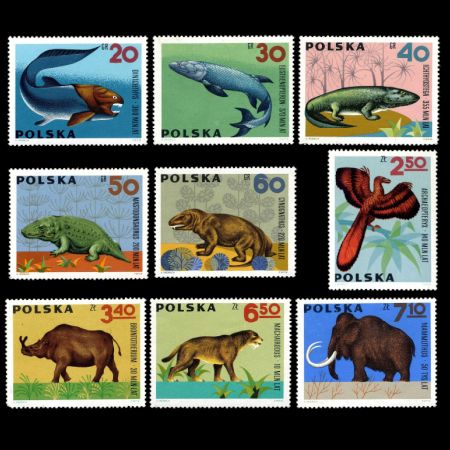
In March 1966 the Ministry of Posts and Telecommunication issued
multicoloured set consisting of nine stamps representing fossil animals
vertebratae. These stamps shows major stages of
vertebratae animal evolution, starts on Devonian fish
Dinichthys, through first, primitive amphibian till well recognized
Mammuthuss. This set is issued just one year after since the first
Polnish stamps depicting dinosaurs
are printed out and two years before Polnish Paleontologist start dig
into Gobi desert together with their Mongolian colleagues. During
several common Polish-Mongolian expeditions many dinosaurs fossils are
found, some of them are on show in museums in Poland and even depict on
stamps issued in
2000.
Illustrations of famous Czechoslovakian painter Zdenek Burian are
issued for these stamps.
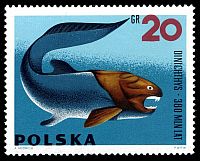 Dinichthys, a Devonian fish of group Arthroctlra
(Gnathostornata) that lived in salt seas 380 million years
ago. She was predator and quite large: 1 meter head and trunk
about 5 feet long. Remains of this fish are also known from and
Devonian sediments of Poland Dinichthys, a Devonian fish of group Arthroctlra
(Gnathostornata) that lived in salt seas 380 million years
ago. She was predator and quite large: 1 meter head and trunk
about 5 feet long. Remains of this fish are also known from and
Devonian sediments of Poland
|
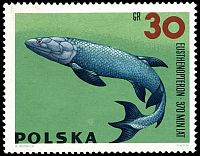 Eusthenopteron, a Devonian fish of group Crossopterygia that
lived in shallow fresh walem 370 years ago, and probably was the
ancestor of first primitive terrestrian, amphibians. A
characteristic feature of this fish are strong, fleshy fins reinforced
with bone skeleton. Eusthenopteron, a Devonian fish of group Crossopterygia that
lived in shallow fresh walem 370 years ago, and probably was the
ancestor of first primitive terrestrian, amphibians. A
characteristic feature of this fish are strong, fleshy fins reinforced
with bone skeleton.
|
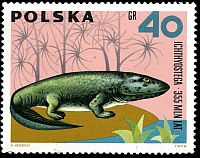 Ichthyostega, a primitive amphibian stili retaining some features of
fishes. It lived about 355 million aears ago in Upper Devonian Ichthyostega, a primitive amphibian stili retaining some features of
fishes. It lived about 355 million aears ago in Upper Devonian
|
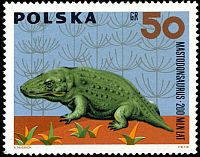 Mastodonsaurus, the biggest amphibian of the Triassic period
(about 200 million years ago) of group Steoocephatia, measuring about 3
meter together with its head (1m about). Mastodonsaurus, the biggest amphibian of the Triassic period
(about 200 million years ago) of group Steoocephatia, measuring about 3
meter together with its head (1m about).
Its probably the first reptilie who
leaved on land. Remains of Mastodonsaurus found in Central Europe:
Germany and Czechoslovakia |
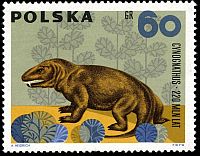 Cynognathus, a Triassic reptile that lived about 220 million years ago.
The animal was a predator and belongs to group of so-called mammal-like
reptiles (Theromorpha). Its body was up to 2 meter long.
Cynognathusa remains are found in the Karroo formation in South Africa. Cynognathus, a Triassic reptile that lived about 220 million years ago.
The animal was a predator and belongs to group of so-called mammal-like
reptiles (Theromorpha). Its body was up to 2 meter long.
Cynognathusa remains are found in the Karroo formation in South Africa. |
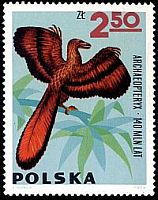 Archaeopteryx the first ancestor of brids in Upper Jurassic
(about 140 million years ago). Its remains found at
lithographic limestone by Solenhofen (Bavaria - Germany). It resembled
birds in having wings and feathers, while its teeth, tail and skuli
showed it was still a reptile It was not actively flying a sbird, but
climbed on a tree by using a sharp claws of the forepaws (wings) and
haggard figure was falling to the ground glide. Has a size more or less
equal to today's pigeon and was an predator who eat some insects,
worms, fruits and seeds. Archaeopteryx the first ancestor of brids in Upper Jurassic
(about 140 million years ago). Its remains found at
lithographic limestone by Solenhofen (Bavaria - Germany). It resembled
birds in having wings and feathers, while its teeth, tail and skuli
showed it was still a reptile It was not actively flying a sbird, but
climbed on a tree by using a sharp claws of the forepaws (wings) and
haggard figure was falling to the ground glide. Has a size more or less
equal to today's pigeon and was an predator who eat some insects,
worms, fruits and seeds. |
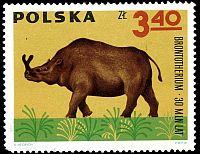 Broutotherium a huge Perissodactyla of
Titanotheridae group lived about 30 million years ago. It combined
features of an elephant (pillar-like legs) and of a
rhinoceros (body structure). Broutotherium a huge Perissodactyla of
Titanotheridae group lived about 30 million years ago. It combined
features of an elephant (pillar-like legs) and of a
rhinoceros (body structure).
Inhabited the steppes of eastern North America and Asia
(Mongolia). His remains were known and are also in Europe. |
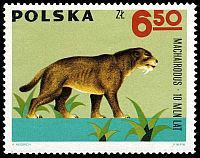 Machairodus, one of the sabze-toothed tigers, one of the most
rapacious representatives of feline family living in the Tertiary,
about 10 million years ago. Machairodus, one of the sabze-toothed tigers, one of the most
rapacious representatives of feline family living in the Tertiary,
about 10 million years ago.
He lived in Europe, Asia and northern Africa during the Miocene and
Pliocene periods. His kinsman is American Smilodon.
Machairodus extinct early in the ice age, and his remains were found
are also in Poland. |
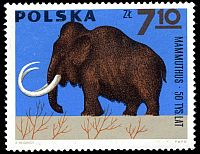 Mammuthus, one of the commonest representatives of the fauna
of glacial period (Pleistocene - about 100-50 thousand years
ago). Lived in the northern areas of Europe, Asia and North
America. His remains are Numerous and Poland. His skeletons are on show
in all major museums in the world Mammuthus, one of the commonest representatives of the fauna
of glacial period (Pleistocene - about 100-50 thousand years
ago). Lived in the northern areas of Europe, Asia and North
America. His remains are Numerous and Poland. His skeletons are on show
in all major museums in the world
(in Poland - at the Museum of the Polish Geological Institute
in Warsaw). Its contemporary cave man hunted it, and
drew its pictures on the walls of the caves.
|
Descriptions of animals served under development by Dr. Andrew
Sulimskiego. (the text above is original stamp description from 1966,
might be obsolete)
Products
| FDC |
Booklet |
|
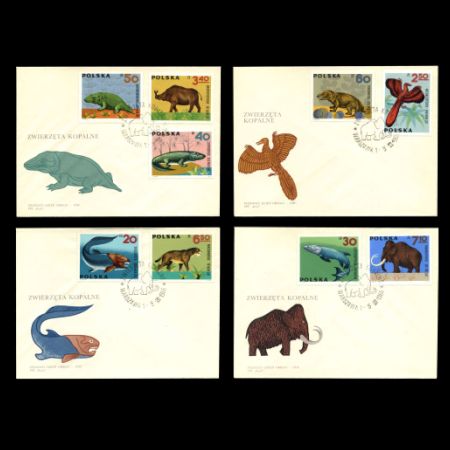
|
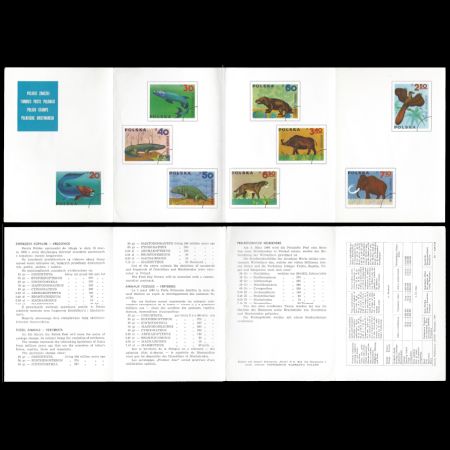
|
|
|
|
|
References:
Filatelista Magazin Nr 5(248) dual language magazin: Polnish/English
Last update 22.11.2017
Any feedback, comments or even complaints
are welcome: [email protected] (you
can email me on ENglish, DEutsch, or RUssian)












